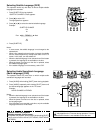
-E31-
REV
SLOW
FWD
SLOW
CLEAR
TRIM
ENTER
SHIFT
S
E
T
U
P
T
O
P
M
E
N
U
S
U
B
T
I
T
L
E
M
E
N
U
2
1, 3
INITIAL SETTINGS
Once the initial settings have been completed, the unit can always be operated under the same conditions.
The settings will be retained in the memory until they are changed, even if the power is turned off.
Notes:
• You cannot switch audio sound track languages if there is
only one language recorded on the disc.
• When you play back a DVD video disc, the unit automatically
displays the pre-selected subtitle language if it is included on
the disc.
• If “OTHERS” is selected, enter the language code. (See
“LANGUAGE CODE LIST” on page E33.)
Common Procedures of Initial Settings
1. Press [SET UP] in the stop mode.
“SET UP MENU (Language, Display, Digital out, and Parental)”
appears on the TV screen.
2. Press [4], [5], [b] or [a], then press [ENTER] to select the
menu. Please refer to the on-screen instructions.
3. Press [SET UP].
Example:
OSD: ENGLISH
AUDIO: DISC, ENGLISH, SPANISH, FRENCH, OTHERS
SUBTITLE: DISC, ENGLISH, SPANISH, FRENCH, OTHERS
DVD MENU: DISC, ENGLISH, SPANISH, FRENCH, OTHERS
(DISC: It will use its first priority language setting.)
TV TYPE: 4:3 LB, 4:3 PS, 16:9
COMPONENT OUTPUT: INTERLACE, PROGRESSIVE
PROGRESSIVE MODE: AUTO, VIDEO, FILM
TV TYPE:
Select the appropriate setting for your TV screen size.
4:3 LB (Letterbox):
Select when a conventional TV set is
connected.
When the wide screen disc is played
back, the black bands appear at the top
and bottom of screen.
4:3 PS (Panscan):
Select when a conventional TV set is
connected.
When the wide screen disc is played
back, it displays pictures cropped to fill
to your TV screen. The left and right
edges are cut off.
16:9 :
Select when a wide screen TV set is
connected.
Played in “FULL” size. (Setting the wide
screen TV to “FULL” mode is also
necessary.)
Notes:
• The screen size may differ depending on the DVD video
discs.
• If you select 16:9 to get rid of the black bands on screen when
wide screen disc is played back, picture may be slightly
distorted.
• In some discs, even if 4:3 PS is selected, the black bands
may remain on the screen.
Cut off Cut off
COMPONENT OUTPUT:
If you use a conventional TV and connect it to the COMPONENT
VIDEO OUT jacks (see Page E10), select “INTERLACE”.
If you use a TV with progressive-scan capability and connect it to
the COMPONENT VIDEO OUT jacks (see Page E12), select
“PROGRESSIVE”.
Notes:
• If the VIDEO OUT SELECT and VIDEO OUT SCAN SELECT
switches are not correct position, you cannot select
“COMPONENT OUTPUT: PROGRESSIVE”.
• If you select “CONPONENT OUTPUT: PROGRESSIVE” when
using a conventional TV, the TV screen is disturbed. In this
case, turn off the power, and then set the VIDEO OUT SCAN
switch to the INTERLACE position.
PROGRESSIVE MODE:
When “COMPONENT OUTPUT: PROGRESSIVE” is selected
as above, select “AUTO”, “VIDEO” or “FILM”.
AUTO:
It automatically selects the Video Source (VIDEO) or Film Source
(FILM). Normally, select this mode.
VIDEO (Video Source):
Major DVD-Video sources consist of video source and film source.
Video source is DVD-Video recording produced by converting
TV programs like drama or animation video (30 frames per
second, 60 fields) into DVD video disc.
FILM (Film Source):
Major DVD-Video sources consist of video source and film source.
Film source is DVD-Video recording produced by converting
movie films (24 frames per second) into DVD video disc.
Notes:
• Initial setting is “AUTO”.
• If picture flickering occurs at “AUTO” mode, select “VIDEO”
or “FILM”.


















